Hiroshima - Japan's Largest Tramway System
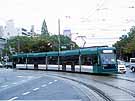 |
|
Siemens built Combino sweeps along a curve on the final
approach to Nishi-Hiroshima. Being first introduced in 1999, now, 12
Combinos serve Hiroshima city running through the heavy rail
right-of-way of the Miyajima Line up to Miyajimaguchi.
October 2002.
|
By Oliver Mayer
In this month's update of the JRS homepage, we want to introduce
Japan's largest and most interesting tramway network, Hiroshima.
Hiroshima is a city of 1.1 million inhabitants, capital of Hiroshima
prefecture and the largest city between Osaka and Kyushu, thus being
the economical centre for much of Western Japan and the Inland Sea.
Hiroshima became world-famous in August 1945, when the American Forces
dropped an atomic bomb over the city.
Today, the network consists of 7 lines:
1: Hiroshima station - Kamiyacho - Hiroshima-ko
2: Hiroshima station - Nishi-Hiroshima - Miyajimaguchi
3: Nishi-Hiroshima - Kamiyacho - Hiroshima-ko
5: Hiroshima station - Hiroshima-ko
6: Hiroshima station - Kamiyacho - Eba
8: Yokogawa - Eba
9: Hakushima - Hatchobori
A line 7 will be introduced in the future, to run from Yokogawa to Kamiyacho, and probably further on to Hiroshima-ko.
Kamiyacho is the centre of the city, with shopping centres, a big
department store (Sogo), the bus centre and the prefectural government
nearby. The A-Bomb-Dome and the baseball stadion are also very close.
As the city centre is several kilometres away from the next railway
stations (Nishi-Hiroshima, Yokogawa, Hiroshima), the tramway has an
important task of connecting the city with the JR stations.
Indeed, that connection was the origin of the tramways. In 1912, the
line between Hiroshima and Nishi-Hiroshima stations opened, together
with two branch-lines, one is today's route 9 to Hakushima, the other
is part of lines 1 and 3 southwards from Kamiyacho. By 1922, the
network had been extended by a line to Yokogawa station, and the
southern route had reached the harbour (now called Hiroshima-ko,
formerly Ujina). The line to Miyajimaguchi was completed in the early
1930s, and during the war, the line to Eba was built, plus a shorter
route from the harbor to the station: this is today's route 5, which
does not go via Kamiyacho.
The total length of the network today is 34.9 km, of which 16.1 km
(the section between Nishi-Hiroshima and Miyajimaguchi) is classified
as railway with speeds up to 70 km/h. In the city, trams do not run
faster than 40 km/h. All lines are standard gauge of 1,435 mm, and are
electrified at 600 V dc. In 2000, a total of 60 million people used the
trams. There are three depots: Eba (terminus of routes 8 and 6), Senda
(also headquarters of Hiroden; on routes 1 and 3 south of Kamiyacho)
and Arate along the Miyajima line.
A single ride is 150 Yen, a one-day ticket is 600 Yen. If you want
to see Miyajima with the famous red torii (shrine-gate) in the sea, it
is useful to get a one-day ticket which includes the ferry for 840 Yen
(note that you cannot use the JR Ferry with this ticket, but the
Matsudai Ferry). Even better value is a 2-day ticket which includes all
trams, the ferry and the ropeway on Miyajima Island, for 2,000 Yen.
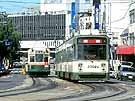
Modern chopper-control #3702 on the right leaving JR Hiroshima
station with old Kyoto car #1007 in opposite direction, at Enkobashi.
September 1992.
|
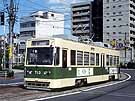
Hiroshima's original car #713 built by Alna-Koki in 1985, at Enkobashi.
September 1992.
|

Naniwa-Koki 1953 built #504, at Kaigandori near Hiroshima Port.
September 1992.
|
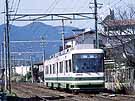
Alna-Koki 1991 built articulated three-car #3903 rolls up
towards Nishi-Hiroshima along the heavy rail right-of-way on the
Miyajima Line, at Hatsukaichi.
March 1999.
|
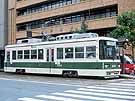
Alna-Koki 1991 built #804 pauses at Chuden-mae tram stop.
October 2002.
|
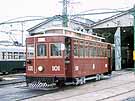
Vintage car #101, restored in 1985, was originally built in
1925. This car is occasionally used when a special event takes place.
October 2002, at Eba depot.
|
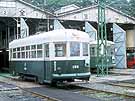
#156, built in 1925, is the oldest car among the Hiroshima fleet.
October 2002, at Eba depot.
|
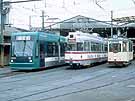
Typical German cars in the Hiroshima tram fleet line up at Senda depot.
October 2002.
|
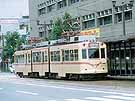
1964 Hitachi built 3006 shows off its articulated figure at Fukuromachi.
October 2002.
|
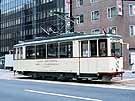
This European car #238, built in 1927, came from Hanover in Germany and serves special events.
October 2002, at Fukuromachi.
|
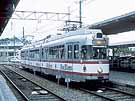
Dortmund car #76, built 1959, stands at Miyajimaguchi, the
western terminus of the Miyajima Line. This car came to Hiroshima in
the 1980s. This car also works on only special services.
October 2002.
|
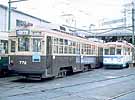
1950 built ex-Osaka car #772 takes a rest at Senda depot.
October 2002.
|
Hiroshima has a very interesting fleet of trams. Of special interest
are tram 238, which was built in 1928 for the German city of Hannover
and is now used for special services (and sometimes on route 9) in
Hiroshima, the sister city of Hannover. Two other used German trams are
from Dortmund, 76 and 77 (built 1959), which came to Hiroshima in the
1980s. Originally it was planned to buy more used German trams to
replace older Japanese rolling stock, but the performance of the trains
was not as expected, and with additional air-conditioning devices on
the roof the cars became rather instable. Today, one car (77) stands in
Arate depot, while 76 is still servicable for charters. More German
cars came between 1999 and 2002, a total of 12 five-section Combinos
from Siemens, all low floor, now making series 5000.
Many trams were built for Hiroshima, but many others came
second-hand from other systems when they closed. Series 570 and 1150 is
from Kobe, 750 and 900 from Osaka, 1900 from Kyoto, and 3000 from
Fukuoka. Hiroshima has a number of relatively new trams, built since
1982, which are series 700, 750 and 800, and also articulated cars 3700
to 3950. Outstanding is tram 3501, which has a chopper-control. While
many tramways in Europe, especially Germany, have copper-controls, only
this tram in Hiroshima and two others in Nagasaki have it.
Many photos on this page were taken during the annual meeting of the
Japan Tramway Society, which was held in Hiroshima in October 2002.
All images in this page were photographed by the author.
[Home Page]












